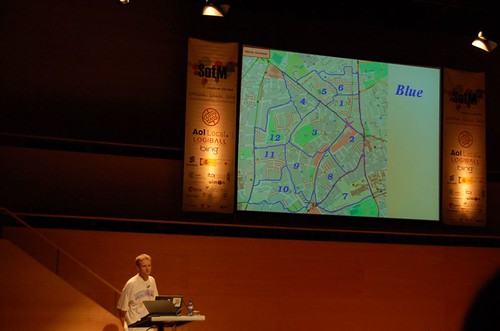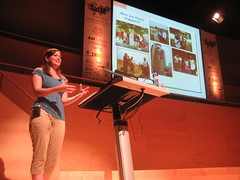
(photo Copyright All rights reserved by SINFOGEO)
Party Time! Good and bad ways to run OpenStreetMap mapping parties
UPDATE: Video of the talk is now available
I seem to have become the chief event organiser for OpenStreetMap in London, not because people massively admire the way I do it, but because it’s actually fair amount of effort, and I’m the one who got suckered into doing it. So this talk was mostly about my experiences of running these regular “mapping party” events, which we do every two weeks as a “mapping party marathon” (Sounds interesting? Check out when the next one is!)As I stressed in my talk, my approach is not ideal. There’s lots of things I don’t get around to doing. In particular I haven’t really tried to drum up press coverage of events. For one reason or another we never have very much luck at attracting new poeple. Although we try to be welcoming to new faces, it mostly ends up being a fun social meet-up where people know eachother. In the questions I was asked “what are my ideas for attracting new people?” to which I gave a hand-waivey response, but the truth is I don’t really know.

So I thought it counterpoised my talk quite nicely when Thea Clay got up and talked about outreach to non-technical communities and spoke about some of the successes she has had reaching out to local community groups and attracting new people to mapping parties in the U.S. This seems like a direction we need to go in, and I hope to find time to try this more in London. But then again…
Ultimately I think the most important message she had, was that OpenStreetMap is too difficult for non-techy people. They get the idea of creating open maps. They enjoy the outdoor aspect of data gathering, and they will have a lot of fun when you first take them out to do this, but the minute they sit down and take a look at our map editing tools “you can see the look on their faces change”.
Perhaps then the most important role of OpenStreetMap events, is to foster the existing OpenStreetMap community in an area. I would even go as far as saying that most outreach work at the moment should target boring old techy people and developers.
This is not the end game. We absolutely want to attract young people and old people, mothers and grandmothers, but getting techy people excited about OpenStreetMap is easier and actually far more effective than anything else at this stage. They’ll learn the tools quicker. But more importantly, these are the people who will go out and embed OpenStreetMap in their websites, taking it to new audiences, or if we’re really lucky they’ll go on to help solve the technical problems of OpenStreetMap and make the next useabilitiy break-throughs.
Obviously any publicity is good publicity. Any mapping party is a good mapping party, but I’m trying to consider where effort is best spent. Are we getting ahead of ourselves to try to engage with local community groups? Maybe I’m just working the geek angle, because that’s what I know best. As I said in my talk, press is important, and press (or PR?) is something OpenStreetMap needs to get better at.
You’re probably right. But then the non-techies probably are more in awe by the fact that you manage at all to convert their just-gathered data into map data usable online right there and then. So they will lean on the tech, but in a supportive, appreciative way. The question is, can you handle the communications? Emails lists etc. Also, maybe you can find people that are more interested in photography than beer who want to take over the blogging and communicating with the media? Seems like that would take a big weight off you. Maybe presenting yourselves differently, less beer centric, would help? Different people react to different incentives, after all. Maybe being the media spokesperson would be incentive enough for some?
That’s true. Non-techy people are perhaps more easily impressed, and it’s gratifying to see a non-technical person getting excited about OpenStreetMap. That cross-over is hugely exciting. It’s what it’s all about. But what I’m wondering is… is it effective right now, to try and run events aimed at non-techy people? It’s difficult to progress a non-techy person as far as truly sowing a seed. We want to either teach someone who then goes on to contribute with their new skills, or get someone to carry the message to new people (or both) I suppose non-technical people can actually be extremely effective at carrying the message, because even though they can’t explain the details of OpenStreetMap, enthusiasm for the project can sound better coming from them.
Presenting ourselves to be less beer-centric? I do wonder about that sometimes 🙂
I think that one approach could be to get teachers use this activities in Geography and computers classes (15/16 years up?). The kids would be great at gathering and editing under some supervision, and it would teach the next generation of the mappers… normally long term changes in society are well supported by this kind of approach. OSM would be a great excuse for school work!